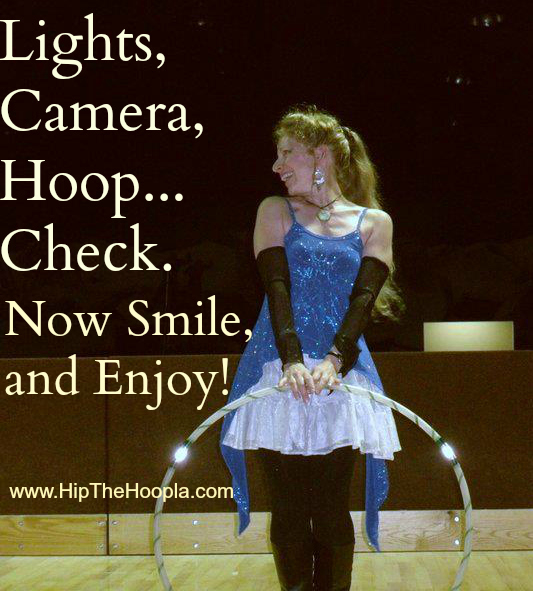7 Choreography Tips + 3 No-Nos and 6 Do-Dos
 by Che’ Rippinger
by Che’ Rippinger
Ever notice that not all performances can be a “Wing-It” type situation-especially non-solos? Sometimes you need to plan a performance with choreography. Here’s 7 cool tips and tricks to make that magic happen…plus 3 No-Nos and 6 Do-Dos.
1. Use what you’ve done
Perhaps you’ve (yes you should!) videotaped yourself and found some cool movement sequences from your dance and hoop flow. Watch, notate and capture those bits and pieces and add them in when creating a choreographed piece.
2. Utilize space
Usually the space you are performing on is more than the spot that you are standing on. Move around forward, back and side to side. And don’t get in a rectangular rut. Just because your stage may be shaped that way doesn’t mean you can’t come up with other geometric movements across it. Yes, math is involved in choreography…if nothing else, than for counting.
3. Change Levels
Operating on one level can become stagnate, no matter how many cool tricks you know. Vary it up. Go up on your toes, plié (knee bend) down, try movements to and from your knees (and protect your joints accordingly, too!). Don’t forget about the space above you-you can use it! And floor work can add a new dimension, too. Do scope out your venue for this, first though. If everyone is sitting at the same level, only your front few rows will see what the heck you are doing down low. A friend of mine jumped off the short sage and was dancing on the audience level. She was eager to know how she did. I know she shimmied and danced very well below shoulder level, but all I could see was her cute mini-top hat!
4. Repeat Sections with Variations
Although repeating a choreography set over and over is not only boring, but downright lazy…there is a way to get away with this. Vary the sections with new elements. Change directions of the movement (side to side goes front to back, or right goes to left). Reverse the movement. If you did it going forward, try going backwards. Also if you think of the variety of planes, you can move things ALL over the place!
5. Transitions
You can have all the coolest moves, but if your hoop dance is trick to trick to trick (or dance movement to movement), even cool stuff isn’t interesting to watch. There’s an old saying: it’s the silence between the notes that makes the music…same is true of dance. Transitions can make the change from one movement to another surprising, flowing, humorous, or really build up the anticipation for your next “wow” move!
6. Strength in Numbers
It’s not always about the solo. With more people comes more possibilities of things to do. Patterns are really fun here. Everyone can go with the grain, opposite of one another, follow each other in a sequence.
7. Get Inspiration Without Copying
There are thousands of YouTube videos, movies and sources of motivational sparks for material and inspiration. Just make sure that you put your own spin on things with your unique style. There’s a fine line between “homage” and “plagerism.” Honor that without crossing it.
The No-Nos:
Don’t mouth the words or the counts! It looks amateurish and like you don’t know what you are doing. Even if you don’t think you know what you are doing, act like you do!
Don’t get the deer in the headlights look if you mess up! Smiling is one of the best defenses here. People know that this is live, and if they are expecting perfection, invite them up to join you. Seriously, brush off the hecklers. You are usually your own worst critic, and should really be your own best cheerleader instead.
Don’t try out your costume onstage without a practice run! There are mounds of horror stories on this–and some are quite dangerous.
The Do-Dos:
1. ) Practice.
2.) Write things down (so you remember it).
3.) Video your work.
4.) Plan and Prep.
5.) Get a second opinion (a practice audience).
6.) And then practice some more.
